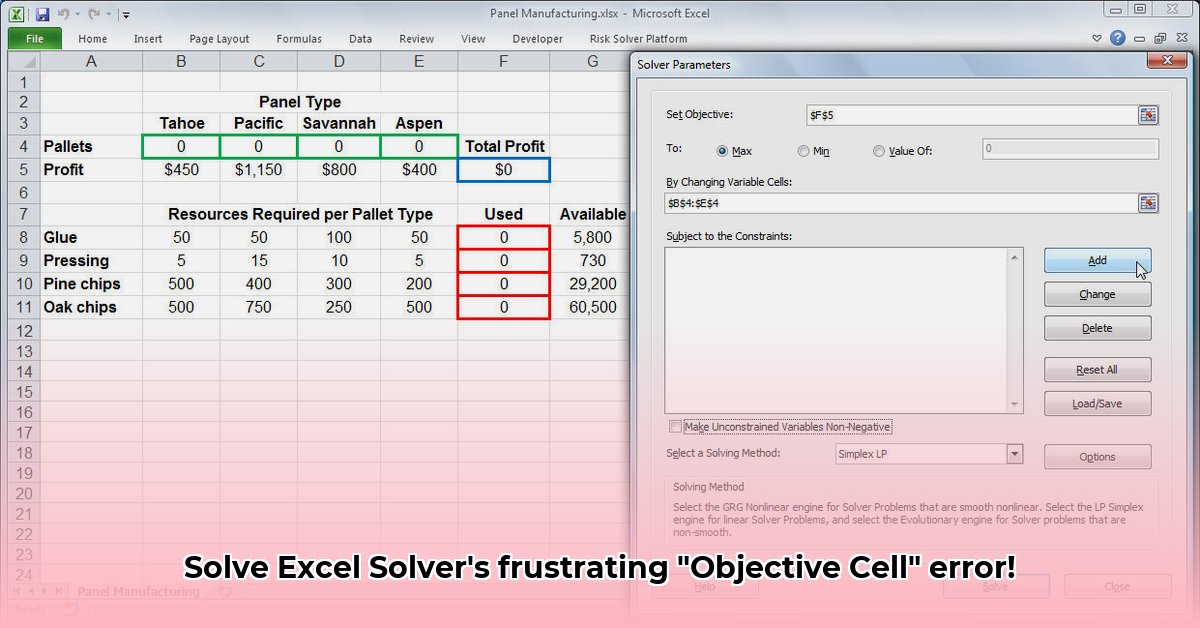
Objective Cell Contents Must Be a Formula: Troubleshooting Excel Solver Errors
Encountering the "Objective cell contents must be a formula" error in Microsoft Excel's Solver tool? This common problem arises when Solver, designed to optimize values by adjusting variables, finds your target cell (the objective cell) contains a static value instead of a formula calculating that value. This guide provides a step-by-step solution for users of all skill levels. Understanding the error is the first step to resolving it quickly and efficiently.
Understanding Solver and the Error Message
Excel Solver acts like a sophisticated optimization engine. You define a target value (in the objective cell), and Solver iteratively adjusts other cells (the changing variable cells) to achieve that target, subject to any constraints you specify. The error, "Objective cell contents must be a formula," signals Solver can’t determine how the objective cell's value relates to your controllable variables—it needs a formula to understand the dependencies. Think of it like providing a baker with a picture of the desired cake but no recipe; the baker (Solver) needs the recipe (the formula) to create the cake (optimal solution).
Step-by-Step Troubleshooting Guide
Let's resolve this error systematically. Follow these steps, examining each point carefully. Many users find the solution within the first few steps.
Step 1: Verify Objective Cell Selection
Locate the Objective Cell: Begin by identifying the cell you've specified in Solver's setup as the objective cell (the cell whose value Solver should optimize). Double-check that you selected the correct cell. This is often the source of the error.
Examine Cell Contents: Now, critically examine that objective cell's contents. Does it contain a formula (starting with an equals sign,
=), or is it simply a numerical value? Solver demands a formula to understand the value's relationship to the other cells.
Step 2: Construct or Correct the Objective Cell Formula
Create a Formula (if missing): If the objective cell lacks a formula, you must insert one. This formula uses cells you've specified as variables (changing cells) in Solver's parameters. This formula defines the relationship between your variables and the objective cell, telling Solver how changes in the variables affect the value of the objective cell.
Review Existing Formula (if present): If a formula already exists, meticulously re-examine it for errors:
- Typos: A single incorrect character can cause significant problems.
- Incorrect Cell References: Verify that all cell references are accurate. Consider using named ranges to improve clarity and reduce errors.
- Correct Operators and Parentheses: Are all operators (
+,-,*,/) and parentheses correctly placed? - Data Type Mismatches: Confirm that the types of data used in the formula (e.g., numbers, text, dates) match the intended formula logic.
Step 3: Confirm Variable Cell References
Check Variable Cells: Solver requires your formula to reference the changing variable cells you've designated in the Solver parameters. Is your objective cell formula correctly linked to the correct variables?
Data Consistency: Are your variable cells populated with numbers? Solver requires numerical values, not text or blank cells.
Step 4: Evaluate Constraints for Consistency and Feasibility
Review Constraints: Examine your Solver constraints. Are there any conflicts or impossibilities among the constraints? Contradictory constraints can prevent Solver from finding a solution.
Constraint Feasibility: Are your constraints realistic? It’s possible that no solution can fulfill all your requirements. If necessary, adjust your constraints to increase the likelihood of finding a solution.
Step 5: Simplify for Better Diagnostics
Break Down Complex Formulas: If the objective cell formula is extremely complex, simplify it. Break the calculation into smaller, more manageable formulas across multiple cells. This makes it easier to identify errors.
Reproduce the Problem in a Simple Model: If extensive modifications exist, create a reduced model with only the essential cells and formulas. This helps isolate the problematic element.
Step 6: Refresh Solver Parameters and the Spreadsheet
Close and Reopen Solver: Sometimes, Solver parameters can become corrupted. Closing and reopening the Solver dialog can resolve minor glitches.
Re-calculate the Worksheet: In the "Formulas" tab, click "Calculate Now" to refresh all cell values and ensure consistency
Common Errors and Solutions
| Error Type | Solution |
|---|---|
| Objective cell contains a constant value instead of a formula | Replace the constant value with a formula that calculates the objective using designated variable cells. |
| Missing or incorrect cell references | Carefully review and correct all cell references in the objective function formula. |
| Formula syntax error (e.g., missing parentheses) | Correct the syntax error in the objective function formula. |
| Circular reference | Identify and remove the circular references indicated by Excel. May require restructuring your calculations. |
| Infeasible constraints | Review and adjust constraints to create a solvable optimization problem. |
| Numerical instability | Try alternative Solver settings or improve the numerical stability of your model. |
By diligently following these steps, you should successfully resolve the "Objective cell contents must be a formula" error and unleash the power of Excel Solver for your optimization tasks. Remember, attention to detail is key!